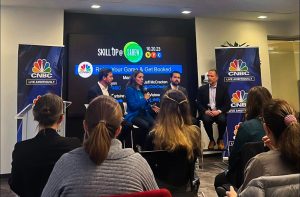As is usually the case this time of year, I’m honored to be asked to judge contests, including a piece of the Society of American Business Editors and Writers awards. In the SABEW contest, especially, one is reminded that in spite of our profession’s challenges great business journalism is being committed all over the country at publications and Web sites of all sizes. That said, the day-in, day-out quality of work at many daily newspapers is not what it was a few years ago.
This is a result of many things outside the control of individual journalists’ control: Staff cutbacks, upper management mandating a new fad every few months or year, less experienced people, distracted editors, and a mania for new technological tools that can take away from the core skills necessary for great journalism. Those tools also give us greater reach than ever, whether in research or presenting stories. The one tool I often find missing, however, is not found online, doesn’t require a developer or producer to create, and is the most essential starting point to great journalism, wherever one works.
CURIOSITY
When I talk to frustrated editors and reporters, this the secret frustration that often dominates the conversation. Too many of their reporters and colleagues lack the ferocious curiosity that makes a great journalist. All the multimedia tools, crowdsourcing and Web platforms in the world can’t make up for an incurious reporter.
We have the best job in the world. We can ask anybody anything. Every day brings something new. Curiosity is our edge. It’s where compelling stories come from. It’s how we make the routine fresh and new. We write the first draft of history, the best available version of the truth. A functioning democracy, free society and accountability of the capitalist system rest on our shoulders. When we fail, as Carl Bernstein says, “The lowest form of popular culture — lack of information, misinformation, misinformation, and a contempt for the truth or the reality of most people’s lives — has overrun real journalism. Today, ordinary Americans are being stuffed with garbage.”
The loss and lack of curiosity has many roots. Veterans burn out. They get sick of covering the same thing, over and over, and nothing seems to change. Sometimes they face editors who turn down stories and can’t articulate why. Other times they don’t know how to pitch that story to get an editor’s interest. New reporters are often thrown in over their heads without coaching or mentoring. Some newsroom cultures are inherently lazy, where the motto is, “We’ve already done that story” — even if they did it 10 years ago. In the age of human resources-driven companies, editors who would give a profane dressing down or be theatrically motivational (I plead guilty to both) are frowned upon. The push to dumb down stories, usually top-down assignments out of the morning meeting, risks turning everybody into a brain-dead worker bee. Continuing layoffs and wondering if our newspapers will even survive are not conducive to a spirit of inquiry.

I don’t know the solutions. Some people aren’t cut out for this job, whether they’re inhibited or lazy. When I worked as a medic years ago, the irascible boss in Scottsdale fired a new EMT because he had lived there his entire life and didn’t know the location of Camelback Mountain. Such people shouldn’t be reporters or editors.
- A few thoughts on jump-starting your curiosity:
- Get out of the newsroom.
- Go somewhere new at least once a week.
- Get out of your car and walk around. Take transit.
- Make a new source at least once a week.
- Call people every day. Say, “Tell me something to put in the newspaper.”
- Break your usual rhythm. Start earlier or work later. Keep a journal. Stop keeping a journal. Anything to see the world around you new.
- Make a tickler file and go back through the morgue. Most news organizations are terrible at follow-ups.
- Read the competition and get mad. How did they beat you? What did they miss? Go back and report something new, something they didn’t have.
The best advice I have is: Fight. My reaction to the calamity that has befallen our calling — I hesitate to call it a “business,” because it is so much more than that — is to fight harder. Even if I’m with the last survivors in the last foxhole, I want to go down fighting. But to do that, I’ve got to stay curious. Downtown Seattle is booming. Except. Except when I wander around the area between the shopping core and the Space Needle, I see dozens of empty storefronts that until the Great Recession housed unique locally owned retailers. Something’s going on.
We are writing the first draft of history in a remarkable time, what I call the Great Disruption. Climate change, a higher cost energy future, globalization, financialization, the shattering of the social compact, political division, rising corporate power — all this and more are making our present and future one of discontinuity. The next 30 years will not be a reprise of the past three decades. When I wrote this a few years ago, most people thought I was crazy. Not so many now.
I’m curious as to why more reporters aren’t digging into this target-rich environment.










